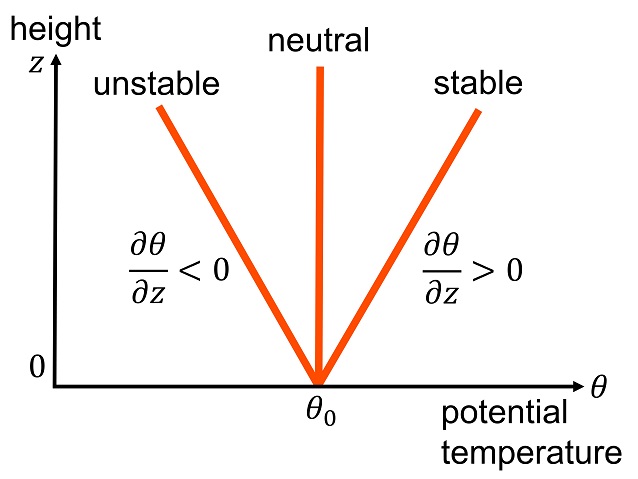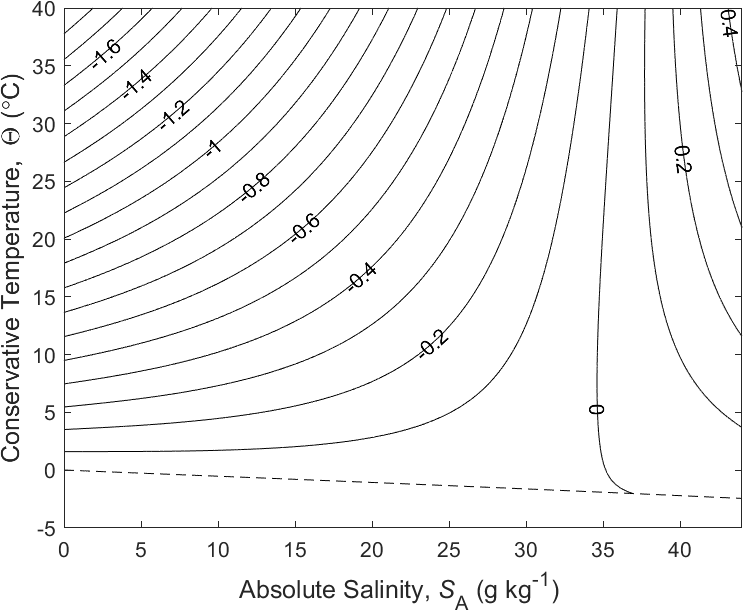|
Potential Temperature
The potential temperature of a parcel of fluid at pressure P is the temperature that the parcel would attain if adiabatically brought to a standard reference pressure P_, usually . The potential temperature is denoted \theta and, for a gas well-approximated as ideal, is given by : \theta = T \left(\frac\right)^, where T is the current absolute temperature (in K) of the parcel, R is the specific gas constant of air, and c_p is the specific heat capacity at a constant pressure. R/c_p = 0.286 for air (meteorology). The reference point for potential temperature in the ocean is usually at the ocean's surface which has a water pressure of 0 dbar. The potential temperature in the ocean doesn't account for the varying heat capacities of seawater, therefore it is not a conservative measure of heat content. Graphical representation of potential temperature will always be less than the actual temperature line in a temperature vs depth graph. Contexts The concept of potential temperatur ... [...More Info...] [...Related Items...] OR: [Wikipedia] [Google] [Baidu] [Amazon] |
Equivalent Potential Temperature
Equivalent potential temperature, commonly referred to as theta-e \left( \theta_e \right), is a quantity that is conserved during changes to an air parcel's pressure (that is, during vertical motions in the atmosphere), even if water vapor condenses during that pressure change. It is therefore more conserved than the ordinary potential temperature, which remains constant only for unsaturated vertical motions (pressure changes). \theta_e is the temperature a parcel of air would reach if all the water vapor in the parcel were to condense, releasing its latent heat, and the parcel was brought adiabatically to a standard reference pressure, usually 1000 hPa (1000 mbar) which is roughly equal to atmospheric pressure at sea level. Use in estimating atmospheric stability Stability of incompressible fluid Like a ball balanced on top of a hill, denser fluid lying above less dense fluid would be dynamically unstable: overturning motions (convection) can lower the center of gravity, an ... [...More Info...] [...Related Items...] OR: [Wikipedia] [Google] [Baidu] [Amazon] |
Wet-bulb Potential Temperature
Wet-bulb potential temperature, sometimes referred to as pseudo wet-bulb potential temperature, is the temperature that a parcel of air at any level would have if, starting at the wet-bulb temperature, it were brought at the saturated adiabatic lapse rate to the standard pressure of 1,000 mbar. This temperature is conservative with respect to reversible adiabatic changes. See also * Wet-bulb temperature * Potential temperature * Atmospheric thermodynamics * Equivalent temperature * Equivalent potential temperature Equivalent potential temperature, commonly referred to as theta-e \left( \theta_e \right), is a quantity that is conserved during changes to an air parcel's pressure (that is, during vertical motions in the atmosphere), even if water vapor condens ... References External links AMS Glossary Oxford Index Atmospheric thermodynamics {{climate-stub ... [...More Info...] [...Related Items...] OR: [Wikipedia] [Google] [Baidu] [Amazon] |
Equivalent Potential Temperature
Equivalent potential temperature, commonly referred to as theta-e \left( \theta_e \right), is a quantity that is conserved during changes to an air parcel's pressure (that is, during vertical motions in the atmosphere), even if water vapor condenses during that pressure change. It is therefore more conserved than the ordinary potential temperature, which remains constant only for unsaturated vertical motions (pressure changes). \theta_e is the temperature a parcel of air would reach if all the water vapor in the parcel were to condense, releasing its latent heat, and the parcel was brought adiabatically to a standard reference pressure, usually 1000 hPa (1000 mbar) which is roughly equal to atmospheric pressure at sea level. Use in estimating atmospheric stability Stability of incompressible fluid Like a ball balanced on top of a hill, denser fluid lying above less dense fluid would be dynamically unstable: overturning motions (convection) can lower the center of gravity, an ... [...More Info...] [...Related Items...] OR: [Wikipedia] [Google] [Baidu] [Amazon] |
Air Parcel
In fluid dynamics, a fluid parcel, also known as a fluid element or material element, is an infinitesimal volume of fluid, identifiable throughout its dynamic history while moving with the fluid flow. As it moves, the mass of a fluid parcel remains constant, while—in a compressible flow—its volume may change, and its shape changes due to distortion by the flow. In an incompressible flow, the volume of the fluid parcel is also a constant ( isochoric flow). Material surfaces and material lines are the corresponding notions for surfaces and lines, respectively. The mathematical concept of a fluid parcel is closely related to the description of fluid motion—its kinematics and dynamics—in a Lagrangian frame of reference. In this reference frame, fluid parcels are labelled and followed through space and time. But also in the Eulerian frame of reference the notion of fluid parcels can be advantageous, for instance in defining the material derivative, streamlines, streaklines, ... [...More Info...] [...Related Items...] OR: [Wikipedia] [Google] [Baidu] [Amazon] |
Atmospheric Boundary Layer
In meteorology, the planetary boundary layer (PBL), also known as the atmospheric boundary layer (ABL) or peplosphere, is the lowest part of the atmosphere and its behaviour is directly influenced by its contact with a planetary surface. On Earth it usually responds to changes in surface radiative forcing in an hour or less. In this layer physical quantities such as flow velocity, temperature, and moisture display rapid fluctuations (turbulence) and vertical mixing is strong. Above the PBL is the "free atmosphere", where the wind is approximately geostrophic (parallel to the isobars), while within the PBL the wind is affected by surface drag and turns across the isobars (see Ekman layer for more detail). Cause of surface wind gradient Typically, due to aerodynamic drag, there is a wind gradient in the wind flow ~100 meters above the Earth's surface—the surface layer of the planetary boundary layer. Wind speed increases with increasing height above the ground, starting ... [...More Info...] [...Related Items...] OR: [Wikipedia] [Google] [Baidu] [Amazon] |
Conservative Temperature
Conservative temperature (\Theta) is a thermodynamic property of seawater. It is derived from the potential enthalpy and is recommended under the TEOS-10 standard (Thermodynamic Equation of Seawater - 2010) as a replacement for potential temperature as it more accurately represents the heat content in the ocean. Motivation Conservative temperature was initially proposed by Trevor McDougall in 2003. The motivation was to find an oceanic variable representing the heat content that is conserved during both pressure changes and turbulent mixing. In-situ temperature T is not sufficient for this purpose, as the compression of a water parcel with depth causes an increase of the temperature despite the absence of any external heating. Potential temperature \theta can be used to combat this issue, as it is referenced to a specific pressure and so ignores these compressive effects. In fact, potential temperature is a conservative variable in the atmosphere for air parcels in dry adiabatic ... [...More Info...] [...Related Items...] OR: [Wikipedia] [Google] [Baidu] [Amazon] |
Atmospheric Thermodynamics
Atmospheric thermodynamics is the study of heat-to-Work (physics), work transformations (and their reverse) that take place in the Earth's atmosphere and manifest as weather or climate. Atmospheric thermodynamics use the laws of classical thermodynamics, to describe and explain such phenomena as the properties of moist air, the formation of clouds, atmospheric convection, boundary layer meteorology, and vertical instabilities in the atmosphere. Atmospheric thermodynamic diagrams are used as tools in the forecasting of storm development. Atmospheric thermodynamics forms a basis for cloud microphysics and convection parametrization (climate), parameterizations used in numerical weather models and is used in many climate considerations, including convective-equilibrium climate models. Overview The atmosphere is an example of a non-equilibrium system. Atmospheric thermodynamics describes the effect of buoyant forces that cause the rise of less dense (warmer) air, the descent of more d ... [...More Info...] [...Related Items...] OR: [Wikipedia] [Google] [Baidu] [Amazon] |
Brunt–Väisälä Frequency
In atmospheric dynamics, oceanography, asteroseismology and geophysics, the Brunt–Väisälä frequency, or buoyancy frequency, is a measure of the stability of a fluid to vertical displacements such as those caused by convection. More precisely it is the frequency at which a vertically displaced parcel will oscillate within a statically stable environment. It is named after David Brunt and Vilho Väisälä. It can be used as a measure of atmospheric stratification. Derivation for a general fluid Consider a parcel of water or gas that has density \rho_0. This parcel is in an environment of other water or gas particles where the density of the environment is a function of height: \rho = \rho (z). If the parcel is displaced by a small vertical increment z', ''and it maintains its original density so that its volume does not change,'' it will be subject to an extra gravitational force against its surroundings of: \rho_0 \frac = - g \left rho (z)-\rho (z+z')\right/math> where g is ... [...More Info...] [...Related Items...] OR: [Wikipedia] [Google] [Baidu] [Amazon] |
Virtual Temperature
In atmospheric thermodynamics, the virtual temperature (T_v) of a moist air parcel is the temperature at which a theoretical dry air parcel would have a total pressure and density equal to the moist parcel of air. The virtual temperature of unsaturated moist air is always greater than the absolute air temperature, however, as the existence of suspended cloud droplets reduces the virtual temperature. The virtual temperature effect is also known as the vapor buoyancy effect. It has been described to increase Earth's thermal emission by warming the tropical atmosphere. Introduction Description In atmospheric thermodynamic processes, it is often useful to assume air parcels behave approximately adiabatically, and approximately ideally. The specific gas constant for the standardized mass of one kilogram of a particular gas is variable, and described mathematically as :R_x = \frac, where R^* is the molar gas constant, and M_x is the apparent molar mass of gas x in kilograms per mo ... [...More Info...] [...Related Items...] OR: [Wikipedia] [Google] [Baidu] [Amazon] |
Integral
In mathematics, an integral is the continuous analog of a Summation, sum, which is used to calculate area, areas, volume, volumes, and their generalizations. Integration, the process of computing an integral, is one of the two fundamental operations of calculus,Integral calculus is a very well established mathematical discipline for which there are many sources. See and , for example. the other being Derivative, differentiation. Integration was initially used to solve problems in mathematics and physics, such as finding the area under a curve, or determining displacement from velocity. Usage of integration expanded to a wide variety of scientific fields thereafter. A definite integral computes the signed area of the region in the plane that is bounded by the Graph of a function, graph of a given Function (mathematics), function between two points in the real line. Conventionally, areas above the horizontal Coordinate axis, axis of the plane are positive while areas below are n ... [...More Info...] [...Related Items...] OR: [Wikipedia] [Google] [Baidu] [Amazon] |
Equation Of State
In physics and chemistry, an equation of state is a thermodynamic equation relating state variables, which describe the state of matter under a given set of physical conditions, such as pressure, volume, temperature, or internal energy. Most modern equations of state are formulated in the Helmholtz free energy. Equations of state are useful in describing the properties of pure substances and mixtures in liquids, gases, and solid states as well as the state of matter in the interior of stars. Though there are many equations of state, none accurately predicts properties of substances under all conditions. The quest for a universal equation of state has spanned three centuries. Overview At present, there is no single equation of state that accurately predicts the properties of all substances under all conditions. An example of an equation of state correlates densities of gases and liquids to temperatures and pressures, known as the ideal gas law, which is roughly accurate ... [...More Info...] [...Related Items...] OR: [Wikipedia] [Google] [Baidu] [Amazon] |
Entropy
Entropy is a scientific concept, most commonly associated with states of disorder, randomness, or uncertainty. The term and the concept are used in diverse fields, from classical thermodynamics, where it was first recognized, to the microscopic description of nature in statistical physics, and to the principles of information theory. It has found far-ranging applications in chemistry and physics, in biological systems and their relation to life, in cosmology, economics, sociology, weather science, climate change and information systems including the transmission of information in telecommunication. Entropy is central to the second law of thermodynamics, which states that the entropy of an isolated system left to spontaneous evolution cannot decrease with time. As a result, isolated systems evolve toward thermodynamic equilibrium, where the entropy is highest. A consequence of the second law of thermodynamics is that certain processes are irreversible. The thermodynami ... [...More Info...] [...Related Items...] OR: [Wikipedia] [Google] [Baidu] [Amazon] |




